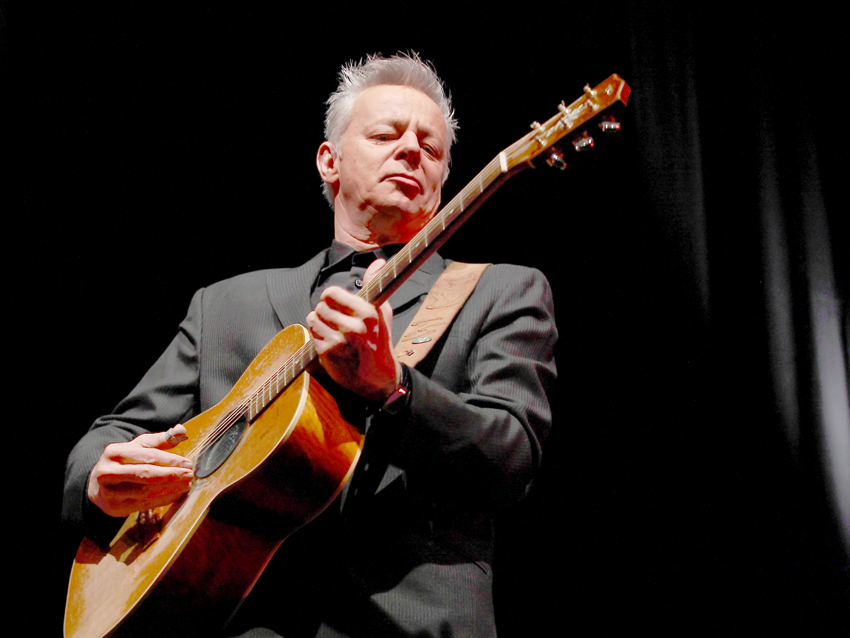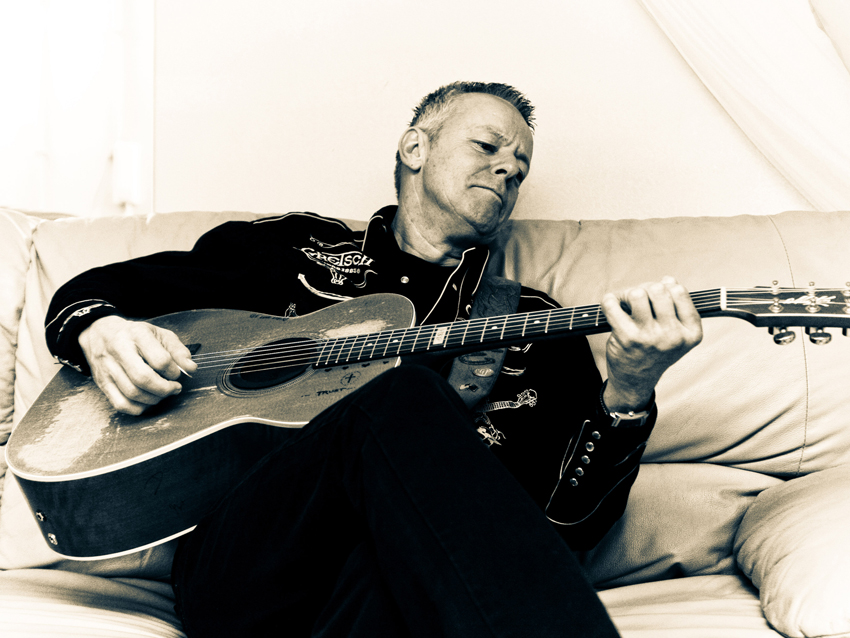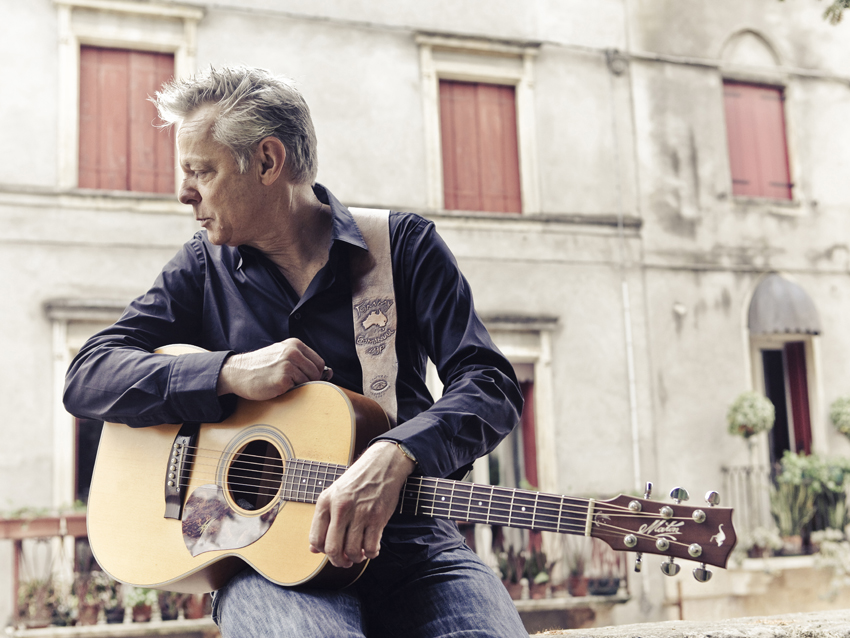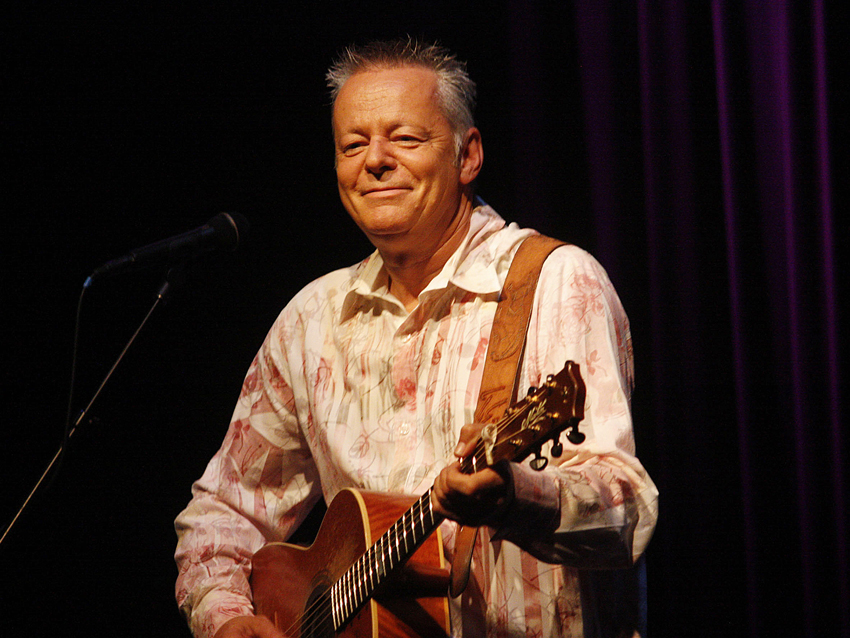Tommy Emmanuel talks The Colonel & The Governer
The Aussie ace on music theory and pushing fingers to the limit

Tommy Emmanuel talks The Colonel & The Governer
For final proof that nothing builds bridges quite like the guitar, consider the two-decade friendship of Tommy Emmanuel and Martin Taylor.
While both men hover around their mid 50s, each is a very different animal. Taylor is the wry, professorial British jazz-cat, who always sounds like he’s raising one eyebrow. Emmanuel is the bluff, self-taught, spade- is-a-spade Australian country wizard, whose nickname – The Colonel – is in keeping with the sense that asking a stupid question will see you marching up and down the square.
These men might never have met had it not been for a mutual love of the big box of air, and they’d never have recorded The Colonel & The Governor, the instrumental album on which they do twisted takes on cherished covers, lofting the bar of technique into orbit, and patently having a damn good time while they’re at it.
At 15:00 hours precisely, Guitarist phoned Colonel Emmanuel. Read on for the full briefing...

When the Colonel met the Governer
Where do the ‘Colonel’ and ‘Governor’ monikers come from?
“Officially, I was made a colonel by the state of Kentucky, and I’ve always called Martin ‘the governor’, because it’s a typical British term that means, you know, the boss, the head guy, the number one. I always called Albert Lee that as well, because I just felt those two guys were so head-and-shoulders above everybody else. Martin once introduced me onto the stage as ‘the abominable showman’. That cracked me up. It was such a clever line.”
How far back does your friendship go?
“Well, what happened was, I saw Martin on TV in the 90s and the station told me where he was staying. So, I rang his hotel and told him he’d better get his guitar and come down to the State Theatre in Sydney, because he was on my show that night. He was like: ‘Er, what?’
We’re opposites, yetit works so well. I was probably one of the first guitar players Martin met that just let it fly and had fun on stage. He’s used to working with guys who are real serious and just sit there... I’m out there like a monkey on stage! We’ve been wanting to record for years, but it’s just getting the chance. Our schedules very rarely intersect, but each time we’ve played together it’s been magic, and we felt we’ve got to record this; we’ve got to put down the fun we have, y’know?”
This is a covers album with a twist, isn’t it?
“Yeah, I always approach arrangements of other people’s songs with the attitude that, no matter what, I’ve got to surprise you at every turn. Who wants to hear a song played like it’s always been done? We found the right mix of songs to give us that chance to fly our own kites.
We emailed lists to each other, Skype’d a couple of times, and the whole thing was decided while we were both on tour in different parts of the world. Some songs, like I Won’t Last A Day Without You, we knew from our teens, but we changed the chords around to make it feel like it was ours.”

Guitar dynamite
The world is expecting guitar dynamite – did that put pressure on you?
“No, not at all. We’re not showing that we’re ‘masters’ or any of that stuff. It’s a window looking into the collaboration between two people who just love to play together. A lot of the subtleties in what we do are missed by people who are only looking at technique. That’s a shame, because there’s so much more in there.”
It doesn’t sound like there’s much ego on this record...
“Oh, doesn’t it? What a shame. Guitar players are always trying, not to outdo each other, but to egg each other on. When you get pushed out on a limb and you really give something all you have, it’s a good feeling to know that, well, if I fall off, I can always fall onto him.”
Was it hard to share the spotlight?
“No, absolutely not. Dividing up the parts was easy. We kinda swapped it around. For instance, Jersey Bounce is mostly Martin playing melodies and me playing accompaniment, then you’ve got tunes like A Smooth One, where I’m taking the verses and Martin takes the bridge. It’s like doing a dance with your favourite dancer – you always know where to put your foot.”
I wouldn’t imagine you need many takes...
“No. Martin can get out of bed and nail it. We kinda road-tested the songs at the Chet Atkins convention in Nashville last July, then we went in the studio and two days later we were finished. All of it was improvised; the only thing that wasn’t was Secret Love. I worked that arrangement out, but everything else is a jam. Does improvising take balls? Well, most players, especially if they’ve been around a little while, can just go into the studio and say: ‘Okay, here’s how the song goes; let’s rip, let’s go.’ So, we just jumped in.”
What acoustic guitars did you reach for?
“Well, I mostly used the guitar I’m going to be playing on the tour, which is a 1930 Martin 0-17, which is a little-bodied, all- mahogany guitar. It has a slight Django kind of sound, and I’m using a bar pickup across the hole as well, for a bit of a 30s and 40s jazz tone – kinda like an old Charlie Christian sound. Martin and I both use the AER Compact 60 amp, but we’re mostly mic’ing up. Martin was using his Peerless guitar with a mic on it, and they took a line off the pickup as well, so he was also going into a DI. And then I was using two mics, and that was all.”
The sound is pretty pure...
“No effects at all, although they may have put some reverb on in the mix. On Down At Cocomo’s, Martin made the steel drum sound by putting someone’s business card through the strings and making it vibrate!”

Making the record
Did you have any other particular guitars up your sleeve?
“There was a brand-new 5th Avenue Godin that Robert Godin gave me to try out. It’s all maple, I think. It’s a beautiful guitar. I think it’s the best model that they’ve ever made. I tried out some of the earlier ones, and they were nice, but they didn’t have what I’d call a ‘classic’ sound. These new ones have definitely got it.
I plugged it direct in, and mic’d it up as well, and I used that on Lullaby Of Birdland. If you listen to that song, it starts out with us both kinda fugue-ing together, then when it comes into the melody, that’s me playing the Godin. On Secret Love, I played my Maton Custom EGB808, because I wanted the midrange to be nice. When I’m doing my own shows, that’s the guitar I play.”
It’s a very unfussy recording. At some points, the listener can actually hear you both chuckling...
“We just left the mics open and sat down, and away we went, just kinda looking across at each other. I think the only thing we fixed up was in one song; Martin went in and fixed the end of one of his solos.
Everything else was just live as it went down.
Like, on Down At Cocomo’s, Martin has to move the capo up, and so instead of trying to do that in a clever, quiet way, you can hear us going: ‘Oh, we’d better have a key change,’ and he moves the capo up, then we go into the next bit. We do that on stage and people crack up.”
Do you think Martin pushes you – and vice-versa?
“I hope so. There’s a real difference between us, and you’ve probably heard it in our playing. Martin definitely comes from the jazz area, and I don’t, so I’ve never learned all those cliché lines that most players play. I’ve learned so much from working with him: chord substitutions, chord ideas. I love the way he interprets melody in that beautiful kinda 40s way – that relaxed way he plays it. You don’t hear people doing that any more.
When I’m around people like that, I’m a real sponge. Playing over some of Martin’s chords was really good for me, because my ear really perked up. I was used to hearing the way that other players interpret songs like The Nearness Of You – but Martin’s chords on that are different from any other player I’ve ever worked with.”

Musical theory and inspiration
Impeccable as you both are as guitar players, do you recognise strengths and weaknesses?
“Oh, absolutely. We know exactly where our strengths and weaknesses are. Aside from what I do with Martin, I’m always personally working on stuff, and so is he, although I think I practise probably a lot more than Martin. What do I still want to improve? My knowledge of modes. I’ve gotta learn more about modes and the technical side of music. Look, I’m very untrained. I don’t read music, I’ve never had lessons, I play everything by ear. And I have a thirst for knowledge all the time.
Sometimes, someone will help me. Like, Frank Vignola, one day, we were playing this tune, and I stopped him and said: ‘Frank, what did you just do there?’ He said: ‘Oh, it’s a semitone diminished run that I got from Django Reinhardt.’ So, I learned it from him, and then I applied it to a lot of other things. He gave me one crumb – and I made a loaf out of it. That’s what I do. But he has that knowledge.”
Does Martin read music?
“I’m sure he does.”
Have you ever considered learning to read music yourself?
“I did try once, and I was hopeless at it. I just don’t have the patience. It wasn’t until I was in my late teens that I was told by enough people that I should really learn how to read music so I could get work
[on the Australian session circuit]. The problem was, I was already getting so much work that I couldn’t keep up with it. I couldn’t read a damn note – but I was busier than a one-armed fiddler! Anyway, I gave it a go, and I was no good at it. It just wouldn’t sink in, you know?”
What can we expect when you and Martin take this out on the road?
“Oh, I think it’s going to be electrifying for everybody, including us. It’s going to be so exhilarating to have this music to play together, and to really edge each other out there. I think we’re going to have a lot of fun.”
You’ve worked with the likes of Eric Clapton, Chet Atkins, Les Paul... who impressed you most?
“Well, if I want to get my dress blown up by a guitar player, I always put on Django. I go back to the source. He’s still the greatest for me. But there are so many players. If you look at the last five years of Joe Satriani’s work, it’s off the chart, it’s phenomenal. Frank Vignola is doing great work, too. There are so many players out there who are inspiring people to be around.”
The Colonel & The Governor is out now on Mesa/Bluemoon Recordings